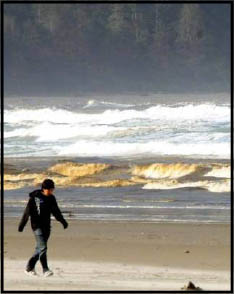|
Aquarium News
Spring is a busy season with many school groups visiting
the Aquarium. In addition to hosting spring visitors, we
have:
- Made a presentation on the history of the Seaside
Aquarium for the Seaside Historical Society.
- Participated in Necanicum Bird and Estuary Day.
- Provided touch tanks at Cannon Beachís Earth Day
Celebration.
- Assisted in two Haystack Rock Awareness Program
training sessions and hosted a third.
- Helped necropsy two baby whales-a gray whale
and a minke whale-for the Marine Mammal
Stranding Network.
How to Tidepool
Here are some tips to help make your trip to the tidepools
productive and safe.
- Use a tide book to determine low tide. Anything
below a 1.0 tide is good for tidepooling.
- Arrive at your destination an hour before low tide,
so you will have plenty of time to look before the
tide changes.
- Watch the surf and use and
common sense. If the tide
 starts coming in, leave (even
if the tidebook says you
should have more time).
starts coming in, leave (even
if the tidebook says you
should have more time).
- Avoid climbing large rocks in
or near the surf. Every year,
people become stuck when
they climb too high and then are stranded as the
tide comes in.
- Respect the habitat you are entering. Tidepools are
home for animals large and small; please tread
lightly, handle animals gently, and return things as you
found them. Take only photos, leave only footprints.
- Donít go alone. The surf zone is beautiful but can be
dangerous as well. It is easy to twist an ankle
navigating the rocks.
- Bring a change of clothes, sunscreen (especially on
cloudy days), towels, and your camera.
- Wear tennis shoes or other shoes that will protect
your feet, NOT SANDALS.
A great place for tidepooling is at Haystack Rock in
Cannon Beach. Trained volunteers and staff are available
during low tides in the summer to answer questions and
show some animals that are normally hidden.
|
|
|
Important Beach Safety
1. Never turn your back on the ocean.
Sneaker waves are very powerful, sometimes strong
enough to knock over an adult.
2. Avoid logs in the surf.
They may look stable, but the ocean can roll logs large
enough to crush you.
3. This is not a safe area for swimming
in the ocean.
Be aware there is a strong undercurrent. Children should
be kept within armís reach and should go no deeper than
their knees.
4. Completely extinguish your campfires.
Embers can burn for days if left or covered.
5. Leave marine mammals alone.
Marine mammals can carry diseases transmittable to humans.
|
New Signs Debunk Oil Myth
Visitors and locals are equally curious and concerned
 about the brown foam that appears regularly in the surf
on Seaside and neighboring beaches. Recently the Seaside
Aquarium has partnered with
the City of Seaside to post
signs around town to inform
the public about the foam.
Donít worry, itís not oil. Itís
diatoms! Diatoms are singlecelled
plants that occur in both
fresh and salt water. There are
a number of different kinds
commonly found in the ocean.
When they occur in large
about the brown foam that appears regularly in the surf
on Seaside and neighboring beaches. Recently the Seaside
Aquarium has partnered with
the City of Seaside to post
signs around town to inform
the public about the foam.
Donít worry, itís not oil. Itís
diatoms! Diatoms are singlecelled
plants that occur in both
fresh and salt water. There are
a number of different kinds
commonly found in the ocean.
When they occur in large
 amounts in the surf zone, they
wash ashore. Diatoms are food
for animals from plankton to
razor clams. They are the sign
of a healthy ecosystem!
For more information check out
the signs located around town.
amounts in the surf zone, they
wash ashore. Diatoms are food
for animals from plankton to
razor clams. They are the sign
of a healthy ecosystem!
For more information check out
the signs located around town.
|

